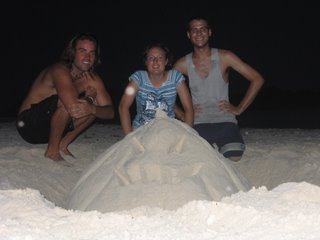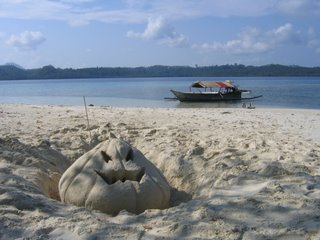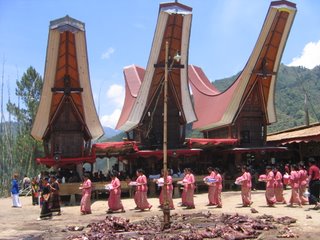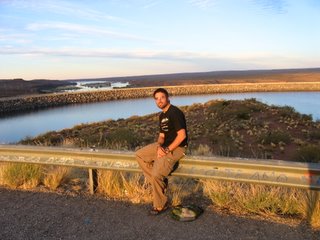Togeans n' Tana Toraja...
Aussies showin' their spirit in celebrating an American holiday.
--sorry 4 the light effect guys--

Nice work, I might add.

So that was my halloween--sand sifting between my toes as the illuminated orbit marched its avenue from the wavy blue to the hill that would be my view for 8 days, Bolilanga. A retreat that reposed this writer into a celestial state; basking, snorkelling, loving all parts of life that rushed to his bungalow's door. Blue-spotted stingrays, crocodile fish, a lobster, humpheaded parrot fish, and on my last snorkel, all alone I was blessed with a white-tipped reef shark about 2m (6ft) that lurked up some 10m from my smilin' snorkel...lovely way to bring in November.
I'm so short of the words that would do justice to my trip in Tana Toraja. It was so characteristic of my luck. The bus into Toraja territory brought my eyes wide open from their drowsy state that is the product of an overnight Indo Bus' journey. The wondrous arching of the traditional houses provoke an affinity that rips thru your entrails and ignites a passion to walkabout.
I had planned to do a little trek of sorts thru some of the villages, but as my path would draw me, I'd never arrive at the intended destination...and all for the better.
Batutumonga was a magnificent place set above a thousand tiers of rice terraces, verdant vistas pushed me up Mt. Sesean, a vegetated rock thrust up to the heavens that was enveloped by clouds by the time I reached.
On my way to the next village, I encountered a "party" in a village about half way from my "planned" stop. It was a funeral procession, a famous Torajan ceremony that brings truck loads of tourists to visit in Jul-Aug and is impressive to say the least. Impressive in every sense of the word, for it can leave you crying, shaking your head, shaking your fist, or just captivated by the strange culture, as was I, that has held on thru the thick Muslim presence of Sulawesi for years and years.
I tore myself away from my plan--which is not an exaggeration--and stormed down the hill with them to witness the buffaloes buttin' brains. To get them fuming, so to speak, they insert chiles into their rectum and draw their leads to the leads of another buffalo and you get a pretty exciting sight. Then I was asked to sit with the well-to-do family that was hosting the funeral "party", where I ate some of the pig that I saw sacrificed just minutes before, then burned with hair and all. Not really sure which part of the pig I was feasting on, but it's strange to feel like royalty, yet still be sitting on the raised floor, eating with my hands, ripping the flesh with my teeth, the juice spilling down my arm.
Oh the stories that ensued, a sick man that let me stay in his shack, then insisted that it "was no problem" to sleep in the same bed with him and his sick child...even though there was another full-size bed completely empty...I couldn't understand. So many more that will have to wait.
I should say first, that the funeral "party" is conducted in two stages. The first is shortly after the death (like in our culture), then another much more extravagant party is held months and sometimes years after. The more important a person is the more money that must be...spent. Some would say wasted, thrown away, etc. but there's much more to their culture than just profligate parties. During this second party, a number of buffalo (which is the base of Toraja culture) and pig are sacrificed in honor of the deceased; again, the greater his life, the greater number of buffalo/pig sacrificed. Many guests/friends from all over the countryside are welcomed on certain days, where there is still a very formal celebration in welcoming them. On another day, the deceased is raised up to his platform where he "presides" over the rest of the ceremony. People take photos with the coffin and treat him as though he were alive. I've heard of some ceremonies where one must ask his permission to leave...I wasn't forced to succumb to such silliness; imagine waiting for an answer.

Welcoming guests with Traditional Toraja rice barns in background
The dead guy I was so lucky to celebrate was quite an important character...thus, I saw more buffaloes sacrificed than I cared to...there's no way to describe the "sacrifice" of 70 buffaloes, more than 200 pigs, and a horse for ONE man.
It is amazing the spirit of sharing this culture represents and there is a lot to be said in defense for their sacrifices; and they make a LOAD of sacrifices.
One buffalo takes on a price from $400US-$20,000. The average cost of the buffaloes in this ceremony was roughly $1500US with the most expensive being $7000US. Now try to understand that figure in a local currency, obtained by an agriculturist; it's mad! Many of them go into debt for their entire lifetime to show their respect for an individual and what they did for their family. It can be touching...all depends on your frame of mind, and what you understand. It must be known that not a single part of the buffalo is wasted...NOTHING! Many tourists see the sight of blood and run away ignoring all the implications of such a society...that's just not fair in my perspective. However, there's not enough space here.
A kind man took me into his "hut" where I spent 2 nights in the frigid conditions of the mountain. People in full-body sarongs double wrapped themselves in rice sacks...a funny sight, but from my warm sleeping bag, I commiserated. This man, Antonios fed me truckloads of Toraja Coffee, I was teaked on toraja's blend as you can imagine drinking more than 15 cups a day...I LOVED IT!!! Actually, Tana Toraja is famous world-wide with their Arabica Blend that is quite pricey. I ate loads of buffalo, pork, more sweet cakes than I ever care to eat again. But I felt like a part of a close family; strolling around to take pictures whenever I felt and with whatever subject I desired...really some great photos.
My last day I woke to see 35 buffalo sacrificed in one go...WOW. They start by tying the beast to a pole in the middle of the bloodied courtyard, but after about 8 enormous creatures fell to their end, they had to tie those that would follow to the horns of the buffalo that lay with throats slashed open. I will never cease to be amazed at the composure each buffalo had while walking up to be fastened to his brother, bloodied and born-again, to await his own slice of destiny. Then taking in the panorama of creatures cut down, hides being torn away, pieces being apportioned, and blood returning to the fields that once provided nourishment for the blessed beautiful beast that is the fundamental of every torajan's life. The way they love this senstive, gentle creature its whole life is inspiring. Waking with it to take it for a nice healthy feed, then washing it down twice a day, to put it to a peaceful sleep. When I speak of how amazing this beast is, I mean that in the fields you hear it purr, softly, gently. While he witnessed the crime (relatively) man was commiting on his species, he couldn't contain himself...and I was drawn to his emotional state that no person could ever call bestial; a buffaloes tear...more real than this picture tells.

Actually to see the daily washing of each man's buffalo is the witnessing of brotherhood; you see man and/or child pull a fistfull of grass from the earth and in the other hand, cupped with water, they begin to soak and scrub it down. The horns, the back, the belly, the twice-over of the bollocks and never depriving him/her of its daily enema...they really love these beasts till their final day. And we all have our final day, don't we?

The first to stand; the dawn of his death


1 Comments:
Hi, noticed your profile on WAYN, and decided to check out your blog. That must have been quite an experience you had in Tana Toraja overall. Anyway, welcome to Singapore, and though we are more of a cosmopolitan city, I hope you'll be able to find something memorable to take home with you.
Post a Comment
<< Home